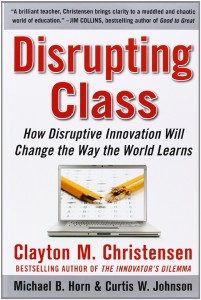
Almost a Three, Solid Four for Americans Only, June 7, 2008
Clayton Christensen
The earlier books on innovation, and especially The Innovator's Dilemma: The Revolutionary Book that Will Change the Way You Do Business (Collins Business Essentials), are better. I strongly recommend that you buy both the above book and this book to have a larger understanding.
The book reads like a Harvard case study fleshed out from 40 pages to 230.
The book has exactly one bottom line: that self-paced instruction using online learning and (this is the cool part) interaction with other languages and cultures (e.g. connect an Arab learning English with an American learning Arabic), is the only way to introduce flexibility. It is this human dimension that carried the book to a four for the US audience only.
Everywhere else in the world they substitute discipline for technology and do quite well. I was troubled by the book/s very narrow focus. There is no consideration in this book, for example, of any of the following (just one example per literature category):
Don't Bother Me Mom–I'm Learning!
Teaching to Transgress: Education as the Practice of Freedom
The Landscape of History: How Historians Map the Past
Fog Facts: Searching for Truth in the Land of Spin
Weapons of Mass Deception: The Uses of Propaganda in Bush's War on Iraq
The Cultural Creatives: How 50 Million People Are Changing the World
Idea Of A University: Philosophy (Notre Dame Series in the Great Books)
Forbidden Knowledge: From Prometheus to Pornography
Collective Intelligence: Creating a Prosperous World at Peace
Flyleaf notes:
+ Need to migrate from monolithic “one size fits all” methods (meaning teacher talks, all listen, or “didactic instruction” to student-centric technologies (my note: rather than human scale and practice)
+ Ages 0-4 are where the child actually learns all the self-confidence and other characteristics needed to succeed down the road (but no real discussion of this and how computers could help, that I saw)
+ Schools are too standardized, need modularity and flexibility (of course this is what the last two generations, and especially Generation 2.0, have been telling us–schools beat the creativity out of kids by the fourth grade, and today the best student drop out of high school rather than sit still for another two years).
+ They give Gardner full credit for discovering multiple intelligences, but they lost me a second time when they focus only on technology as the innovative solution, and fail to properly develop the theme for art, music, theater, social work, apprenticeships, and etcetera. This is a book with one simple message and focus on computers in the US classroom.
+ Schools have four jobs (none of them actively discussed in dollar and cents or program planning terms):
– Preserve democracy, inculcate values
– Provide something for every student
– Keep America competitive (ha. China graduates more HONOR students than we graduate students across the board)
– Eliminate poverty (this is a bit lame, reflecting no appreciation for structured inequalities outside the classroom, as well as political disenfranchisement and banking fraud including red-lining for future development profit).
The authors repeat one of the pearls of wisdom from The Innovators Dilemma (link in first line above), and suggest that those who wish to innovate should go after those not served, citing Apple's genius in offering its early computers as toys for children.
+ Four factors are in favor of innovation (in US schools):
– Computer-based learning keeps improving (see Don't Both Me Mom, link above, that book ends with recommendations for learning programs across the board that are online now)
– All can select pathways (this assumes they have been taught discipline and curiosity someplace along the line)
– Looming teacher shortage (I agree–advanced child care and factory worker angle are history–we need to learn to learn in all places)
– Costs fall significantly as market scales
They spend too much time on three business models, my first hint this might be a Harvard Case Study in book form:
– Solution shops
– Value chains
– Facilitated user networks
I write down from the book “best to combine disruptive business model with disruptive commercial system.” I have no idea what this means. From the poverty literature (see my lists), I received the idea of hybrid organizations, non-profits that catalyzed profits sufficient to attract foreign investment, e.g. low cost nutritious yogurt for children in India). Perhaps that is what they mean, I concluded after reading this twice that maybe they meant go after those not served *and* make it free at first (upgrades can cost).
Harnessing user-generated content is a key idea that may not be noticed. It is in fact the foundation for Web 2.0 and I expect the human factor will continue to scale in importance and the cost of technology declines.
The book ends weakly, with disappointing coverage of the 0-4 age or on educational research needed. They conclude with short messages for various stakeholder groups.
I went back through the book a second time, and would note that there are some very clever useful visualizations in the book, especially Figure 8.2 on page 187, and these alone are worth the price of the book.
In the end for me, the book was worthwhile but could have so much better if they had started with innovation ideas for each of the stake-holder groups they address in ending. The five billion poor are never going to be educated in a classroom, but we *can* give out free cell phones and create two call centers, one in China and one in India, that combine Internet access, Skype free telephone access, and access to a global network of 100 million or more volunteers able to answer any question in any language, free, at the time of it value to the poor person asking the question. THAT is world-class innovation because it creates infinite wealth, and does not limit itself to justifying charter schools because they can buy more computers.



